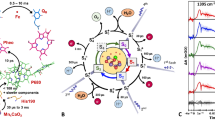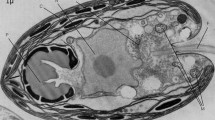Abstract
Although the importance of nonphotochemical quenching (NPQ) on photosynthetic biomass production and crop yields is well established, the in vivo operation of the individual mechanisms contributing to overall NPQ is still a matter of controversy. In order to investigate the timescale and activation dynamics of specific quenching mechanisms, we have developed a technique called snapshot transient absorption (TA) spectroscopy, which can monitor molecular species involved in the quenching response with a time resolution of 30 s. Using intact thylakoid membrane samples, we show how conventional TA kinetic and spectral analyses enable the determination of the appropriate wavelength and time delay for snapshot TA experiments. As an example, we show how the chlorophyll-carotenoid charge transfer and excitation energy transfer mechanisms can be monitored based on signals corresponding to the carotenoid (Car) radical cation and Car S1 excited state absorption, respectively. The use of snapshot TA spectroscopy together with the previously reported fluorescence lifetime snapshot technique (Sylak-Glassman et al. in Photosynth Res 127:69–76, 2016) provides valuable information such as the concurrent appearance of specific quenching species and overall quenching of excited Chl. Furthermore, we show that the snapshot TA technique can be successfully applied to completely intact photosynthetic organisms such as live cells of Nannochloropsis. This demonstrates that the snapshot TA technique is a valuable method for tracking the dynamics of intact samples that evolve over time, such as the photosynthetic system in response to high-light exposure.







Similar content being viewed by others
References
Ahn TK, Avenson TJ, Ballottari M et al (2008) Architecture of a charge-transfer state regulating light harvesting in a plant antenna protein. Science 320:794–797. https://doi.org/10.1126/science.1154800
Amarnath K, Bennett DIG, Schneider AR, Fleming GR (2016) Multiscale model of light harvesting by photosystem II in plants. Proc Natl Acad Sci USA 113:1156–1161. https://doi.org/10.1073/pnas.1524999113
Balevičius V, Fox KF, Bricker WP et al (2017) Fine control of chlorophyll-carotenoid interactions defines the functionality of light-harvesting proteins in plants. Sci Rep 7:1–10. https://doi.org/10.1038/s41598-017-13720-6
Barber J, Anderson B (1992) Too much of a good thing: light can be bad for photosynthesis. Trends Biochem Sci 17:61–66. https://doi.org/10.1016/0968-0004(92)90503-2
Barzda V, Gulbinas V, Kananavicius R et al (2001) Singlet-singlet annihilation kinetics in aggregates and trimers of LHCII. Biophys J 80:2409–2421
Bennett DIG, Fleming GR, Amarnath K (2018) Energy-dependent quenching adjusts the excitation diffusion length to regulate photosynthetic light harvesting. Proc Natl Acad Sci USA. https://doi.org/10.1073/pnas.1806597115
Berteotti S, Ballottari M, Bassi R (2016) Increased biomass productivity in green algae by tuning non-photochemical quenching. Sci Rep 6:21339. https://doi.org/10.1038/srep21339
Bode S, Quentmeier CC, Liao P-N et al (2009) On the regulation of photosynthesis by excitonic interactions between carotenoids and chlorophylls. Proc Natl Acad Sci USA 106:12311–12316. https://doi.org/10.1073/pnas.0903536106
Demmig-Adams B, Adams WW III, Barker DH et al (1996) Using chlorophyll fluorescence to assess the fraction of absorbed light allocated to thermal dissipation of excess excitation. Physiol Plant 98:253–264
Dreuw A, Fleming GR, Head-Gordon M (2003) Charge-transfer state as a possible signature of a zeaxanthin-chlorophyll dimer in the non-photochemical quenching process in green plants. J Phys Chem B 107:6500–6503. https://doi.org/10.1021/jp034562r
Gilmore AM, Shinkarev VP, Hazlett TL, Govindjee (1998) Quantitative analysis of the effects of intrathylakoid pH and xanthophyll cycle pigments on chlorophyll a fluorescence lifetime distributions and intensity in thylakoids. Biochemistry 37:13582–13593. https://doi.org/10.1021/bi981384x
Ginting RT, Jeon MK, Lee KJ et al (2017) Degradation mechanism of planar-perovskite solar cells: correlating evolution of iodine distribution and photocurrent hysteresis. J Mater Chem A 5:4527–4534. https://doi.org/10.1039/c6ta09202k
Głowacka K, Kromdijk J, Kucera K et al (2018) Photosystem II Subunit S overexpression increases the efficiency of water use in a field-grown crop. Nat Commun 9:868. https://doi.org/10.1038/s41467-018-03231-x
Gulbinas V, Valkunas L, Kuciauskas D et al (1996) Singlet-singlet annihilation and local heating in FMO complexes. J Phys Chem 100:17950–17956. https://doi.org/10.1021/jp961272k
Hernandez JL, Reichmanis E, Reynolds JR (2015) Probing film solidification dynamics in polymer photovoltaics. Org Electron Phys Mater Appl 25:57–65. https://doi.org/10.1016/j.orgel.2015.05.025
Holt NE, Zigmantas D, Valkunas L et al (2005) Carotenoid cation formation and the regulation of photosynthetic light harvesting. Science 307:433–436. https://doi.org/10.1126/science.1105833
Hontani Y, Kloz M, Polívka T et al (2018) Molecular origin of photoprotection in cyanobacteria probed by watermarked femtosecond stimulated Raman spectroscopy. J Phys Chem Lett 9:1788–1792. https://doi.org/10.1021/acs.jpclett.8b00663
Kromdijk J, Glowacka K, Leonelli L et al (2016) Improving photosynthesis and crop productivity by accelerating recovery from photoprotection. Science 354:857–862
Li Z, Wakao S, Fischer BB, Niyogi KK (2009) Sensing and responding to excess light. Annu Rev Plant Biol 60:239–260. https://doi.org/10.1146/annurev.arplant.58.032806.103844
Liguori N, Periole X, Marrink SJ, Croce R (2015) From light-harvesting to photoprotection: structural basis of the dynamic switch of the major antenna complex of plants (LHCII). Sci Rep 5:15661. https://doi.org/10.1038/srep15661
Liguori N, Xu P, van Stokkum IHM et al (2017) Different carotenoid conformations have distinct functions in light-harvesting regulation in plants. Nat Commun 8:1994. https://doi.org/10.1038/s41467-017-02239-z
Llansola-Portoles MJ, Litvin R, Ilioaia C et al (2017) Pigment structure in the violaxanthin–chlorophyll-a-binding protein VCP. Photosynth Res 134:51–58. https://doi.org/10.1007/s11120-017-0407-6
Ma Y-Z, Holt NE, Li X-P et al (2003) Evidence for direct carotenoid involvement in the regulation of photosynthetic light harvesting. Proc Natl Acad Sci USA 100:4377–4382. https://doi.org/10.1073/pnas.0736959100
Miloslavina Y, Wehner A, Lambrev PH et al (2008) Far-red fluorescence: a direct spectroscopic marker for LHCII oligomer formation in non-photochemical quenching. FEBS Lett 582:3625–3631. https://doi.org/10.1016/j.febslet.2008.09.044
Müller P, Li X-P, Niyogi KK (2001) Non-photochemical quenching. A response to excess light energy. Plant Physiol 125:1558–1566. https://doi.org/10.1104/pp.125.4.1558
Müller MG, Lambrev P, Reus M et al (2010) Singlet energy dissipation in the photosystem II light-harvesting complex does not involve energy transfer to carotenoids. ChemPhysChem 11:1289–1296. https://doi.org/10.1002/cphc.200900852
Park S, Fischer AL, Li Z et al (2017) Snapshot transient absorption spectroscopy of carotenoid radical cations in high-light-acclimating thylakoid membranes. J Phys Chem Lett 8:5548–5554. https://doi.org/10.1021/acs.jpclett.7b02486
Park S, Fischer AL, Steen CJ et al (2018) Chlorophyll-carotenoid excitation energy transfer in high-light-exposed thylakoid membranes investigated by snapshot transient absorption spectroscopy. J Am Chem Soc 140:11965–11973. https://doi.org/10.1021/jacs.8b04844
Park S, Steen C, Lyska D, Fischer AL (2019) Chlorophyll-carotenoid excitation energy transfer and charge transfer in Nannochloropsis oceanica for the regulation of photosynthesis. Proc Natl Acad Sci USA 116:3385–3390
Pascal AA, Liu Z, Broess K et al (2005) Molecular basis of photoprotection and control of photosynthetic light-harvesting. Nature 436:134–137. https://doi.org/10.1038/nature03795
Polívka T, Sundström V (2004) Ultrafast dynamics of carotenoid excited states—from solution to natural and artificial systems. Chem Rev 104:2021–2071
Porra RJ, Thompson WA, Kriedemann PE (1989) Determination of accurate extinction coefficients and simultaneous equations for assay in chlorophylls a and b extracted with four different solvents. Biochim Biophys Acta 975:384–394
Ruban AV, Berera R, Ilioaia C et al (2007) Identification of a mechanism of photoprotective energy dissipation in higher plants. Nature 450:575–578. https://doi.org/10.1038/nature06262
Sacharz J, Giovagnetti V, Ungerer P et al (2017) The xanthophyll cycle affects reversible interactions between PsbS and light-harvesting complex II to control non-photochemical quenching. Nat Plants. https://doi.org/10.1038/nplants.2016.225
Staleva H, Komenda J, Shukla MK et al (2015) Mechanism of photoprotection in the cyanobacterial ancestor of plant antenna proteins. Nat Chem Biol 11:287–291. https://doi.org/10.1038/nchembio.1755
Sylak-Glassman EJ, Zaks J, Amarnath K et al (2016) Characterizing non-photochemical quenching in leaves through fluorescence lifetime snapshots. Photosynth Res 127:69–76. https://doi.org/10.1007/s11120-015-0104-2
Vieler A, Wu G, Tsai CH et al (2012) Genome, functional gene annotation, and nuclear transformation of the heterokont oleaginous alga Nannochloropsis oceanica CCMP1779. PLoS Genet. https://doi.org/10.1371/journal.pgen.1003064
Wahadoszamen M, Margalit I, Ara AM et al (2014) The role of charge-transfer states in energy transfer and dissipation within natural and artificial bacteriochlorophyll proteins. Nat Commun 5:1–8. https://doi.org/10.1038/ncomms6287
Wang H, Whittaker-Brooks L, Fleming GR (2015) Exciton and free charge dynamics of methylammonium lead iodide perovskites are different in the tetragonal and orthorhombic phases. J Phys Chem C 119:19590–19595. https://doi.org/10.1021/acs.jpcc.5b04403
Werley CA, Teo SM, Nelson KA (2011) Pulsed laser noise analysis and pump-probe signal detection with a data acquisition card. Rev Sci Instrum. https://doi.org/10.1063/1.3669783
Wilson KS, Wong CY (2018) In situ measurement of exciton dynamics during thin-film formation using single-shot transient absorption. J Phys Chem A 122:6438–6444. https://doi.org/10.1021/acs.jpca.8b06248
Acknowledgements
We thank Drs. Dagmar Lyska and Masakazu Iwai for helpful discussions and for providing Nannochloropsis oceanica samples. We also thank Lam Lam for helpful assistance during her visit to the University of California, Berkeley. This work was supported by the U.S. Department of Energy, Office of Science, Basic Energy Sciences, Chemical Sciences, Geosciences, and Biosciences Division under Field Work Proposal 449B. G. R. F. thanks Magdalen College, Oxford for a visiting Fellowship, and the Department of Physical and Theoretical Chemistry, Oxford for their hospitality during the writing of this paper.
Author information
Authors and Affiliations
Corresponding author
Ethics declarations
Conflict of interest
The authors declare that they have no conflict of interest.
Additional information
Publisher's Note
Springer Nature remains neutral with regard to jurisdictional claims in published maps and institutional affiliations.
Rights and permissions
About this article
Cite this article
Park, S., Steen, C.J., Fischer, A.L. et al. Snapshot transient absorption spectroscopy: toward in vivo investigations of nonphotochemical quenching mechanisms. Photosynth Res 141, 367–376 (2019). https://doi.org/10.1007/s11120-019-00640-x
Received:
Accepted:
Published:
Issue Date:
DOI: https://doi.org/10.1007/s11120-019-00640-x




